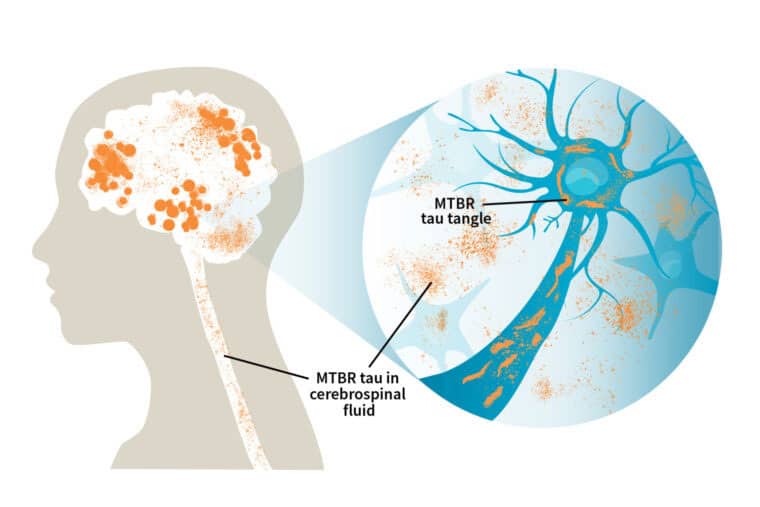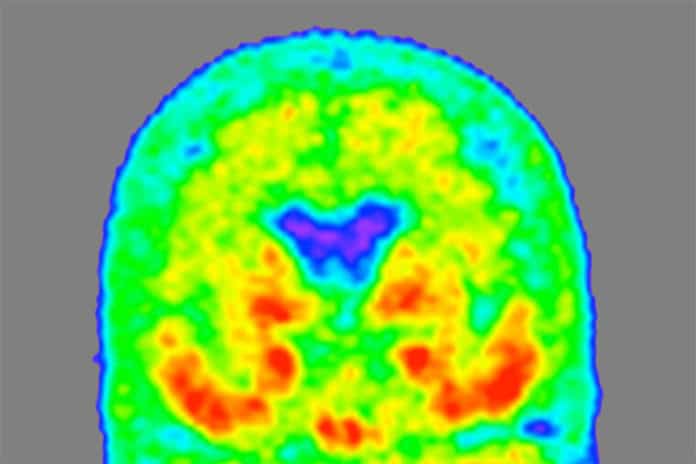Alzheimer’s disrupts processes vital to neurons and their networks, including communication, metabolism, and repair. It all began when a brain protein called amyloid started forming plaques in the brain.
People show no symptoms of cognitive decline during this amyloid stage. Although tangles of tau protein in the brain start spreading in the neurons, people start exhibiting confusion and memory loss, and brain scans show increasing atrophy of brain tissue.
A technique called positron emission tomography (PET) is used to detect Tau tangles in brain scans, but brain scans are time-consuming, expensive, and not available everywhere.
Recently, scientists from Washington University School of Medicine in St. Louis have identified a novel form of Alzheimer’s protein in the fluid that surrounds the brain and spinal cord. The protein indicates the current stage of the disease a person is in. It also tracks with tangles of tau protein in the brain.
According to scientists, this discovery of microtubule-binding region tau (MTBR tau) in the cerebrospinal fluid could lead to a way to diagnose people in the earliest stages of Alzheimer’s disease before they have symptoms or when their symptoms are still mild and easily misdiagnosed.
Senior author Randall J. Bateman, MD, the Charles F. and Joanne Knight Distinguished Professor of Neurology said, “This MTBR tau fluid biomarker measures tau that makes up tangles and can confirm the stage of Alzheimer’s disease by indicating how much tau pathology is in the brains of Alzheimer’s disease patients. If we can translate this into the clinic, we’d have a way of knowing whether a person’s symptoms are due to tau pathology in Alzheimer’s disease and where they are in the disease course without needing to do a brain scan. As a physician, this information is invaluable in informing patient care, and in the future, to guide treatment decisions.”
Bateman and first author Kanta Horie, a visiting scientist in Bateman’s lab, realized that specific MTBR tau species were enriched in the brains of people with Alzheimer’s disease and that measuring levels of the species in the cerebrospinal fluid that bathes the brain might be a way to gauge how broadly the toxic tangles have spread through the brain.

To detect MTBR tau in the cerebrospinal fluid, scientists came up with a new method based on using chemicals to purify tau from a solution, followed by mass spectrometry.
The technique helped scientists analyze cerebrospinal fluid from 100 people in their 70s. Thirty had no cognitive impairment and no signs of Alzheimer’s; 58 had amyloid plaques with no cognitive symptoms or mild or moderate Alzheimer’s dementia, and 12 had cognitive impairment caused by other conditions.
Scientists found that levels of a specific form — MTBR tau 243 — in the cerebrospinal fluid were elevated in people with Alzheimer’s. It increased the more advanced a person’s cognitive impairment and dementia were.
The results were verified by following 28 members of the original group over two to nine years. Half of the participants had some degree of Alzheimer’s at the start of the study. Over time, levels of MTBR tau 243 significantly increased in the Alzheimer’s disease group, in step with a worsening of scores on tests of cognitive function.
To see how their technique matched up to the gold standard, the researchers compared the amount of tau visible in brain scans of 35 people — 20 with Alzheimer’s and 15 without — with levels of MTBR tau 243 in the cerebrospinal fluid. MTBR tau 243 levels were positively correlated with the amount of tau identified in the brain scan, suggesting that their technique accurately measured how much tau — and therefore damage — had accumulated in the brain.
Horie said, “Right now, there is no biomarker that directly reflects brain tau pathology in cerebrospinal fluid or the blood. We’ve found here that a novel form of tau, MTBR tau 243, increases continuously as tau pathology progresses. This could be a way for us to not only diagnose Alzheimer’s disease but tell where people are in the disease. We also found some specific MTBR tau species in the space between neurons in the brain, suggesting that they may be involved in spreading tau tangles from one neuron to another. That finding opens up new windows for novel therapeutics for Alzheimer’s disease based on targeting MTBR tau to stop the spread of tangles.”
Journal Reference:
- Kanta Horie, Nicolas R Barthélemy, Chihiro Sato, Randall J Bateman, CSF tau microtubule-binding region identify tau tangle and clinical stages of Alzheimer’s disease. Brain, awaa373, DOI: 10.1093/brain/awaa373
